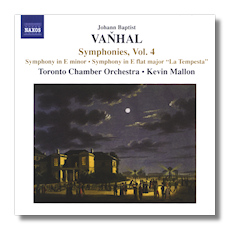
The Internet's Premier Classical Music Source
Related Links
- Vanhal Reviews
- Latest Reviews
- More Reviews
-
By Composer
-
Collections
DVD & Blu-ray
Books
Concert Reviews
Articles/Interviews
Software
Audio
Search Amazon
Recommended Links
Site News
 CD Review
CD Review
Johann Baptist Vanhal

Symphonies, Volume 4
- Symphony in E minor, Bryan e3
- Symphony in C Major, Bryan C1
- Symphony in C Major, Bryan C17
- Symphony in E Flat Major, Bryan E1
Toronto Chamber Orchestra/Kevin Mallon
Naxos 8.570280 DDD 66:12
Thanks to Naxos, it is possible for modern listeners to explore the 18th-century symphony in greater breadth and detail than ever before. Of course Naxos is not the first label to give us symphonies by Vanhal, Cannabich, Benda, Stamitz, Kraus, and many others, but few labels have persevered to this degree. (Note that this is the fourth release devoted to Vanhal alone.) Part of the reason this has been possible is Artaria Editions, a publishing house founded in the mid 1990s to make music from that era available to today's performers and scholars. The present disc contains four works published by Artaria in 1999 and 2002. The editor of these editions was Paul Bryan, who also wrote the detailed booklet notes for this CD.
Vanhal (1739-1813), whose name sometimes (and probably more correctly) is spelled "Wanhal," is one of the more interesting figures of his era. The conventional wisdom used to be that he suffered from some sort of nervous disorder, perhaps of a hyper-religious nature, when he was younger, and that when he recovered in the 1770s, his music became less interesting. Two of these symphonies were composed prior to 1770, and two after, and I can discern no falling-off in quality. He was born in Bohemia, studied with Dittersdorf, and is said to have made music with Haydn and Mozart. He was prolific – there are approximately 75 symphonies, for example – and if he was not an innovator in the manner of Haydn or Mozart, there's no mistaking his expertise. His symphonies do not suffer in comparison to many of those by the two aforementioned composers.
The Symphony in E flat, for example, begins with a busy and amiable Allegro, with many passages in 16th notes for the strings. Contrasting minor episodes add interest and drama. The second movement, a lightly melancholy Adagio, is in the rhythm of a siciliano, and in some ways suggests Vivaldi as well as Haydn. The succeeding Menuetto features rising scales with "bowing" figures to end the phrases. The Trio, on the hand, seems content to rest in the shade. Unusually for a symphony by this composer, the final movement has a subtitle, "La Tempesta," or "The Storm," and this is depicted in the music within the limits of that era's stylistic conventions. Bryan and others have suggested that this symphony might be Vanhal's "Four Seasons."
On this recording, the Toronto Chamber Orchestra features a string complement of 6:4:3:2:1, plus flute, two oboes, bassoon, two horns, two trumpets, and timpani. This is a modern instruments ensemble, but the performances per se are stylistically appropriate, free of exaggeration – fairly middle-of-the-road, in fact – but definitely not lacking interest. They should satisfy most people. The engineering is similarly pleasing.
Copyright © 2008, Ray Tuttle




















